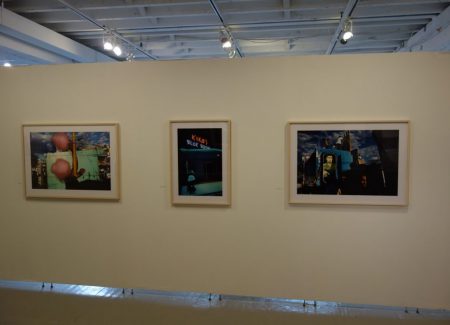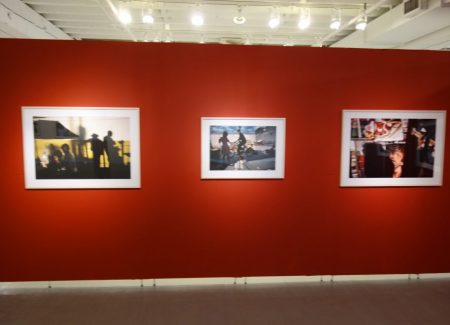JTF (just the facts): A total of 45 black and white and color photographs, generally framed in white and unmatted, and hung against white, red, yellow, and blue walls in the main gallery space and the entry area. 44 of the works are digital c prints, made between 1979 and 2007. These prints are sized roughly 25×34 (in editions of 20) or 32×45 (in editions of 12). The single black and white work on view is a fiber print, made in 1978. It s sized 16×20 and available in an edition of 20. (Installation shots below.)
A monograph of this body of work was recently published by Aperture (here). Hardcover, 176 pages, with 86 color and black and white reproductions. Includes essays by Guillermo Arriaga, Álvaro Enrigue, Valeria Luiselli, Guadalupe Nettel, and Mónica de la Torre. (Cover shot below.)
Comments/Context: Making photographs in the street is by its very nature an exercise in serendipity. In just a split second, an ordinary moment can coalesce into something visually extraordinary, only to disappear just as quickly into the bustling flow of the day. And for those who have never tried to capture this kind of magic, being-in-the-right-place-at-the-right-time chance might seem like all it takes to make great street pictures. But Alex Webb’s superlative show of street work from Mexico should dispel such overly easy myths. It is a consistent triumph of compositional complexity, and a deeply satisfying educational proof that thoughtfully sophisticated photographic framing can be exhilarating.
Starting with a single black and white image from the late 1970s and continuing through three subsequent decades of color work, the exhibit wanders the streets of cities across Mexico, and with only a handful of exceptions, all of the images are enlivened by the presence of people. Of course, there are busy storefronts and bars, street vendors and blurred passing traffic, border fences and dusty neighborhoods, each providing its own particular backdrop and cultural context. But its the vivid motion of people that seems to continually catch Webb’s eye – and it becomes the central tool he uses for organizing his pictures.
But even before we notice the careful alignment of various actors on Webb’s stage, we cannot help but be seduced by his vibrant colors. Perhaps it is the nature of the Mexican sunlight or a societal affection for bright decoration, but there is something truly glorious about the richness of the color seen here. Webb manages this color with the knowledge that too much saturation can be overpowering, and many of his best pictures deftly control the color, allowing it to spark here and there without dominating the images. The blue of the sky, a wall in yellow or orange or turquoise, a pink dress, a red awning, a white dog – nearly every picture is anchored by color that provides compositional weight, balance, or interest. Tints of color are equally powerful, especially at twilight or after dark, when fluorescent bulbs and neon signs bathes the scenes in soft purple, or melancholy blue, or a sickly creeping green.
While withering sun blasted light does populate some of Webb’s photographs, many more are interrupted by dark shadows. Webb seems to be particularly aware of how a shadow can be drawn into his compositions. Shadows double central figures, introduce silhouettes of players off stage, create uneasy differences in scale, and bring large swaths of blackness into the frame, almost like abstract geometries. In Webb’s hands, a shadow isn’t an afterthought or an unintended byproduct, but something to be actively managed and used to best effect.
More generally, most of Webb’s photographs are intensely layered, with strict attention paid to foreground and background action. Again and again, we see scenes playing out on multiple levels, the depth of the space allowing for visual stories that operate in different planes. Perhaps the most famous of these is Webb’s improvised symphony in blue, where a boy spins a blue ball in the foreground, while a gaggle of friends plays in the background surrounded by the dappled blue and white of the formal architecture, each boy somehow wearing a shirt in stripes of blue and white. Other combination pictures are given life by frontal and side interruptions, where a moving hand or a painted horse juts in to reorient the action; mirrors are used to similar effect, bouncing the path of our eyes from one place to another.
This compositional approach leads to an overall feeling of competition for attention, and to a broad picture of Mexican streets that teem with life and embrace their own contradictions. The young share space with the old, death lingers in the gutter, Jesus mingles with Santa and the Backstreet Boys, young men take chances on the border, and couples find time for a quick but passionate embrace in the shadows. In Webb’s images, we feel the sweaty heat, hear the cacophony of sounds, and shield our eyes from the sun.
But irrespective of the lively and nuanced subject matter, Webb’s photographs offer a master class in street composition – there is deliberate intelligence to be found in the construction of nearly every picture. For those that worry that the iPhone-toting hordes will soon overrun photography, Webb’s pictures offer a soothing antidote of high quality craftsmanship. As I passed from image to image, my head was continually nodding, acknowledging the real pleasure that is derived from smartly built photographs.
Collector’s POV: The prints in this show are priced in rising editions. For the color works, the 25×34 prints start at $3500 and the 32×45 prints start at $5000. The black and white prints begin at $3000. Webb is represented by a variety of galleries including Etherton Gallery (here), Stephen Daiter Gallery (here), Robert Koch Gallery (here), Robert Klein Gallery (here), and Stephen Bulger Gallery (here). Webb’s work has little secondary market history, so gallery retail remains the best option for those collectors interested in following up.




















